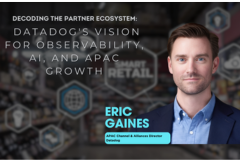Alok Sharma, Director – Channels (India & SAARC), Autodesk, in a conversation with itVARnews, shares his thoughts on growth, achievements and new business model of Autodesk,amidst the ongoing pandemic
Please talk about the highlights of your achievements in terms of business growth, customer acquisitions and new innovations in 2021.
Our customers continue to embrace and prioritize digital transformation to drive growth, efficiency, and sustainability, generating strong demand for Autodesk’s platform. This is demonstrated in the financial results of the first three quarters of the current fiscal year.
As part of our overall business strategy, over the past two years Autodesk has acquired cloud-based product lifecycle management and product management solutions provider Upchain; water infrastructure design company Innovyze and AI and generative design platform vendor Spacemaker.
Upchain: The addition of Upchain to the Autodesk portfolio accelerates our mission to deliver the next-generation software platform for design and manufacturing and creates more value for customers by removing collaboration barriers and increasing efficiency and resiliency.
Innovyze: Our acquisition of Innovyze positions Autodesk as a leading global provider of end-to-end digital solutions from design to operations of water infrastructure, accelerates Autodesk’s digital twin strategy, and creates a clearer path to a more sustainable and digitized water industry.
Spacemaker: The acquisition of Spacemaker provides Autodesk with a powerful platform to drive modern, user-centric automation and accelerate outcome-based design capabilities for architects, urban designers and planners.
Please talk about few major developments in your business processes/model which enabled improvement in business in 2021.
We’ve built a robust and resilient subscription business which has provided flexibility and have now focused on our Cloud offerings, therefore enabling work-from-home with ease. This has allowed our customers to not be impacted by us working remotely.
Completely unique to Autodesk, we are building a platform to enable data to flow. We will extend our cloud services to connect data experiences across solutions, igniting a new developer ecosystem. As this ecosystem grows, the data in the platform will become more valuable, driving more insights and users, more usage, and workflows which in turn will drive more apps and extensions – what we call a flywheel of growth.
Undeniably, now more than ever, our largest opportunity to create positive impact at scale is by supporting our customers in automating complex processes with the technology they need to unlock insights, make better decisions, and achieve superior outcomes to improve the impact of everything they design, make, own, and operate. Cloud solutions and connected data environments fuel innovation—across technology, processes, supply chains, and industries. And this opportunity is growing exponentially.
With the ongoing pandemic, what are the changes you see in the relations between brands, channels, and customers?
The pandemic has demonstrated that we need to be flexible, agile, and be able to adapt quickly as things unfold. The most important thing has been to stay connected with our channel eco system and retain those strong relationships we were able to build prior to the pandemic. Leveraging technologies during this period, moving to cloud offerings enabling a smooth remote working transition, as well as the benefits of a common data environment are all things that have driven new relationships.
Assisting our partners in the move to predominately a digital focus and how to better reach their customers has also been vital, from a marketing and sales perspective. Prior to the pandemic, our partners didn’t see the value of digital and social platforms, with less than 10 percent leveraging these. But now with changing scenario, over 85 percent of our ecosystem has a digital presence. We have seen some focused digital campaigns come from some of our India partners during the pandemic. Two great examples of this include: One partner focusing on solution selling with a customer focus, utilizing their customer’s story to build out a campaign, as well as another partner who created an industry competition that created social awareness and created enormous impact in the market.
What is your outlook for the technology industry over the next 2-3 years?
Government initiatives, such as Atmanirbhar Bharat, will harness the power of connected data and artificial intelligence (AI) to help companies automate their engineering and manufacturing processes, driving push-button automation. The rapid adoption of digital technologies has generated a lot of speculation about machines replacing humans. This is the arrival of augmented intelligence, in which cognitive computing capabilities help humans make better decisions, faster. European sporting goods retailer Decathlon, for example, is now using AI to design and manufacture its performance bicycles more efficiently, making them lighter, more durable, and faster while slashing design-phase emissions.
In construction, India is expected to become the world’s 3rd largest construction market, with construction output to grow on average by 7.1 percent each year. There is more government spending with multiple projects such as PMAY, Bharatmala, Bharat-net Project, Jal Jeevan Mission and Affordable Housing Projectin various sectors including airports, urban and rural infrastructure, railways, power and renewable energy, irrigation, water treatment plants and waterways.
With 66 percent of construction companies in India prioritizing digital transformation, the construction sector has seen an increased acceptance of digital construction solutions. Research has found that 20 percent of construction firms in the country have implemented BIM in large residential, commercial and industrial projects.As the Internet of Things (IoT), AI and cloud-computing technologies drive the industry’s digital transformation, digital twins are gaining traction.According to McKinsey in 2016, large projects are, on average, up to 80 percent over budget.
 Latest Technology News Today – Get Latest Information Technology Updates and Services Latest Technology News Today – Get Latest Information Technology Updates and Services
Latest Technology News Today – Get Latest Information Technology Updates and Services Latest Technology News Today – Get Latest Information Technology Updates and Services 









